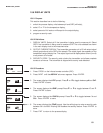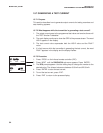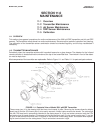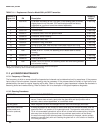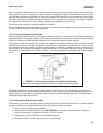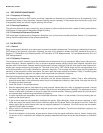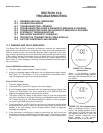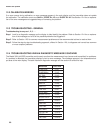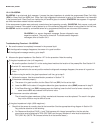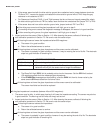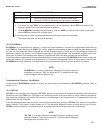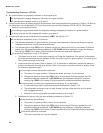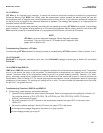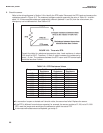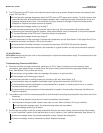
91
MODEL 3081 pH/ORP SECTION 12.0
TROUBLESHOOTING
12.4.1 GLASSFAIL
GLASSFAIL is an electrode fault message. It means the glass impedance is outside the programmed Glass Fault High
(GFH) or Glass Fault Low (GFL) limit. Glass Fault High suggests the electrode is aging or the electrode is not immersed
in the process liquid. Glass Fault Low implies the pH sensitive glass is cracked. GLASSFAIL also appears if inappropri-
ate limits have been entered into the transmitter.
If the measurement system was previously commissioned and operating correctly, GLASSFAIL likely means a real prob-
lem exists. However if the system is being started up or if the advanced diagnostic feature is being used for the first time,
GLASSFAIL could be caused by a miswired sensor or by programmed limits that are not correct for the sensor.
NOTE
GLASSFAIL is a sensor diagnostic message. Sensor diagnostic mes-
sages are optional. They can be turned off. To disable sensor diagnostic
messages, refer to Section 8.4.3.
Troubleshooting Flowchart - GLASSFAIL
A. Be sure the sensor is completely immersed in the process liquid.
If the diagnostic message disappears, the sensor is in good condition.
If the diagnostic message remains, go to step B.
B. Measure the glass impedance. See Section 12.7 for the procedure. Note the reading.
If the glass impedance is low (<40 megohms)...
1. Be sure the position of switch S-1 on the analog board matches the location of the preamplifier. See Section 2.2.
If switch S-1 was correct go to step 2.
If moving the switch to the correct position makes the diagnostic message disappear, the sensor is in good con
dition.
If after moving the switch, the glass impedance is still low, go to step 2.
2. Calibrate the sensor. Use the autocalibration procedure in Section 7.5.
If the sensor calibrates properly...
a. The sensor is in good condition, but the Glass Fail Low (GFL) limit is set too high.
b. Lower the GFL limit to about 10 megohms below the glass impedance value (GIMP) measured in step B.
c. If the Glass Warning Low (GWL) message was also flashing, lower the limit from its former value by the
same amount GFL was lowered from its former value.
If the sensor cannot be calibrated...
The pH sensitive glass membrane is likely cracked and the sensor must be replaced. The crack in the glass
may not be visible or may be difficult to see.
If the glass impedance is high (>800 megohms)...
1. Check that the sensor is correctly wired to the transmitter. See the appropriate wiring diagram in Section 3.0.
Pay particular attention to the following:
a. For Rosemount Analytical PLUS (+) and TUpH sensors with integral preamplifiers, the blue solution
ground wire must be attached to TB-8 (SOL GND) and the gray reference in wire must be attached to
TB-7 (REF IN). (NOTE: TB-8 means terminal 8 on the terminal board.)



